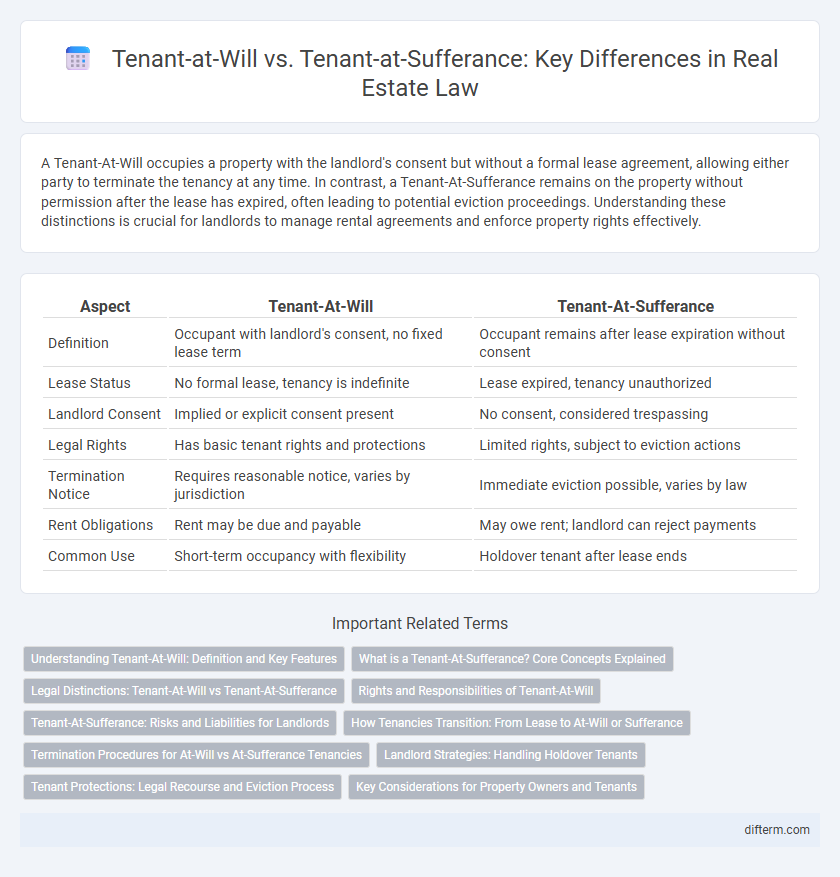A Tenant-At-Will occupies a property with the landlord's consent but without a formal lease agreement, allowing either party to terminate the tenancy at any time. In contrast, a Tenant-At-Sufferance remains on the property without permission after the lease has expired, often leading to potential eviction proceedings. Understanding these distinctions is crucial for landlords to manage rental agreements and enforce property rights effectively.
Table of Comparison
| Aspect | Tenant-At-Will | Tenant-At-Sufferance |
|---|---|---|
| Definition | Occupant with landlord's consent, no fixed lease term | Occupant remains after lease expiration without consent |
| Lease Status | No formal lease, tenancy is indefinite | Lease expired, tenancy unauthorized |
| Landlord Consent | Implied or explicit consent present | No consent, considered trespassing |
| Legal Rights | Has basic tenant rights and protections | Limited rights, subject to eviction actions |
| Termination Notice | Requires reasonable notice, varies by jurisdiction | Immediate eviction possible, varies by law |
| Rent Obligations | Rent may be due and payable | May owe rent; landlord can reject payments |
| Common Use | Short-term occupancy with flexibility | Holdover tenant after lease ends |
Understanding Tenant-At-Will: Definition and Key Features
A Tenant-At-Will occupies a property with the landlord's consent without a formal lease agreement, allowing either party to terminate the tenancy at any time with proper notice. This arrangement offers flexibility for short-term occupancy but lacks long-term security for both tenant and landlord. Key features include no fixed rental period, rent payment acceptance as implicit agreement, and termination typically requiring a statutory notice period.
What is a Tenant-At-Sufferance? Core Concepts Explained
A Tenant-At-Sufferance occupies a property without the landlord's consent after the lease has expired, effectively staying illegally. This status arises when a tenant remains in the unit without a new lease agreement, making them liable for eviction but still responsible for rent. Understanding this distinction is crucial for landlords to enforce property rights and initiate proper eviction proceedings.
Legal Distinctions: Tenant-At-Will vs Tenant-At-Sufferance
Tenant-at-will agreements allow a tenant to occupy property with the landlord's consent without a fixed lease term, providing both parties the right to terminate the tenancy at any time with proper notice. In contrast, a tenant-at-sufferance occupies the property without legal permission after the lease has expired, effectively holding over and potentially subject to eviction. Legal distinctions impact the landlord's rights to pursue eviction and claim rent, as tenant-at-will statuses require notice for termination, whereas tenant-at-sufferance may lead to immediate legal action.
Rights and Responsibilities of Tenant-At-Will
Tenant-At-Will holds possession of a rental property with the landlord's consent but without a formal lease agreement, granting flexible tenancy but limited security. This tenant must comply with all rental obligations, including timely rent payment and property upkeep, while the landlord retains the right to terminate the tenancy with proper notice. Unlike Tenant-At-Sufferance, a Tenant-At-Will has lawful possession and the right to remain until the landlord decides to end the arrangement.
Tenant-At-Sufferance: Risks and Liabilities for Landlords
Tenant-at-sufferance status poses significant risks and liabilities for landlords, as these occupants remain on the property without a valid lease agreement, increasing the complexity of eviction processes. Landlords face potential financial losses due to unauthorized occupancy, delayed rent payments, and possible property damage since the tenant has no legal right to possess the property. Navigating tenant-at-sufferance situations requires landlords to understand local laws on eviction timelines and damages claims to mitigate prolonged disputes and protect their investment.
How Tenancies Transition: From Lease to At-Will or Sufferance
Tenancies transition from a formal lease to tenant-at-will status when a lease expires without renewal or a new agreement, granting the tenant temporary occupancy with landlord consent but no fixed term. If the tenant continues to occupy the property after the lease ends without the landlord's permission, the status shifts to tenant-at-sufferance, creating a holdover situation subject to eviction or rent increase. Understanding these transitions is crucial for property owners to manage occupancy rights and avoid unauthorized tenancy complications.
Termination Procedures for At-Will vs At-Sufferance Tenancies
Termination procedures for Tenant-At-Will tenancies typically require the landlord to provide a notice period defined by state law, often 30 days, without the need to state cause for ending the lease. Conversely, Tenant-At-Sufferance occupants have overstayed without landlord consent after lease expiration and may face immediate eviction proceedings without prior notice. Courts generally prioritize protecting At-Will tenants by enforcing proper notice requirements, whereas At-Sufferance tenancy termination focuses on regaining possession swiftly through legal action.
Landlord Strategies: Handling Holdover Tenants
Landlords facing holdover tenants must differentiate between Tenant-At-Will and Tenant-At-Sufferance statuses to apply effective eviction or lease renewal strategies. For Tenant-At-Will, landlords may negotiate month-to-month agreements or issue proper notice to terminate tenancy, leveraging flexible lease terms. In contrast, dealing with Tenant-At-Sufferance requires immediate legal actions, such as filing for eviction due to unauthorized possession, to protect property rights and avoid financial losses.
Tenant Protections: Legal Recourse and Eviction Process
Tenants-at-will have more robust legal protections, including proper notice requirements and opportunities to remedy lease violations before eviction. In contrast, tenants-at-sufferance possess minimal rights and can be evicted swiftly as they occupy the property without any legal rental agreement. Understanding these distinctions is critical for landlords and tenants to navigate eviction processes lawfully and avoid legal disputes.
Key Considerations for Property Owners and Tenants
Tenant-at-will agreements grant tenants occupancy with the landlord's consent but without a fixed term, allowing either party to terminate tenancy with proper notice, while tenants-at-sufferance remain on the property after lease expiration without permission, creating potential legal risks. Property owners must understand eviction processes and notice requirements for tenants-at-sufferance to avoid unlawful detainer claims, whereas tenants-at-will benefit from flexible occupancy but face unpredictability in lease continuation. Clear communication, documentation, and understanding local landlord-tenant laws are crucial for both parties to protect rights and manage property effectively.
Tenant-At-Will vs Tenant-At-Sufferance Infographic

 difterm.com
difterm.com